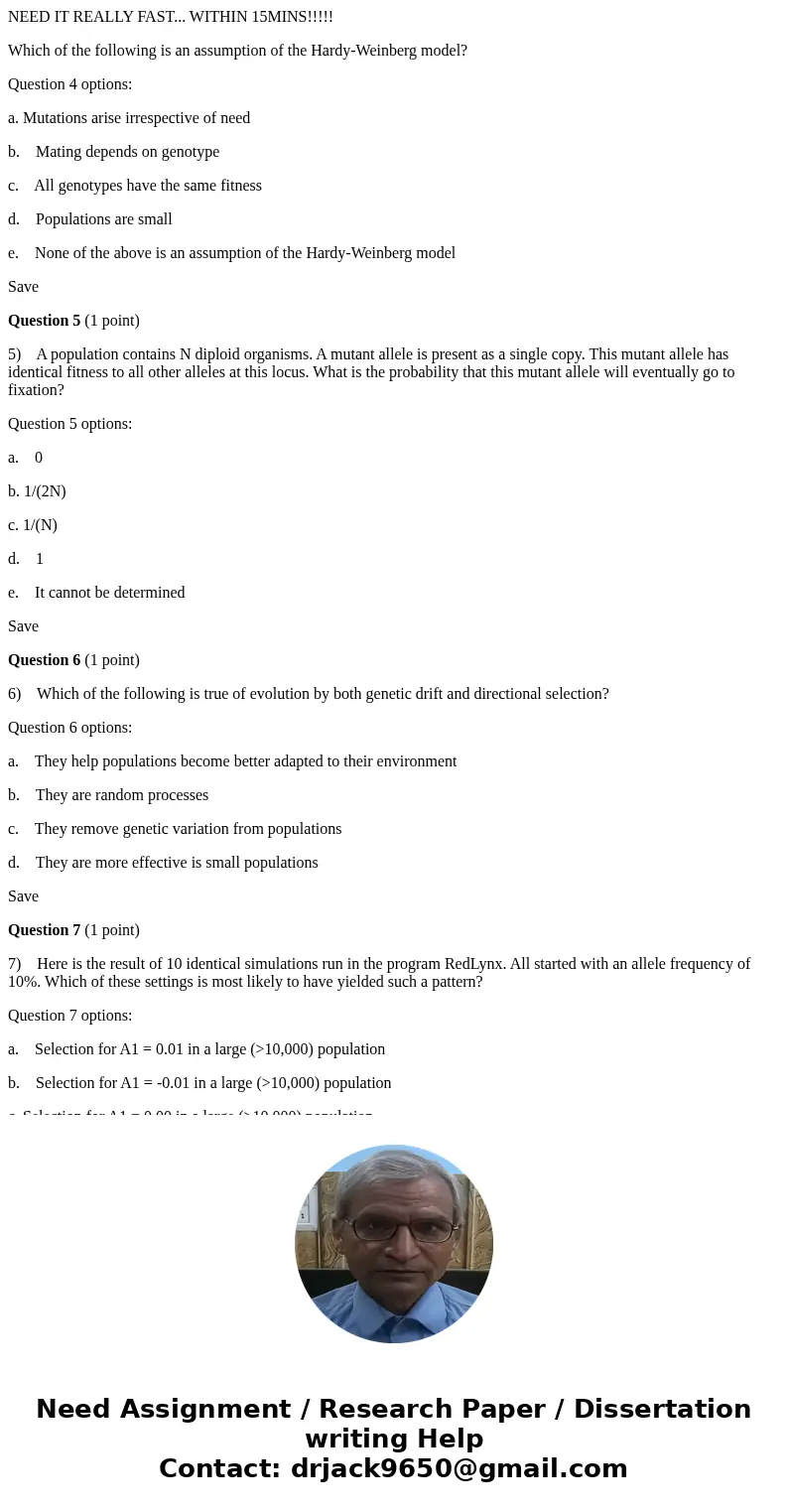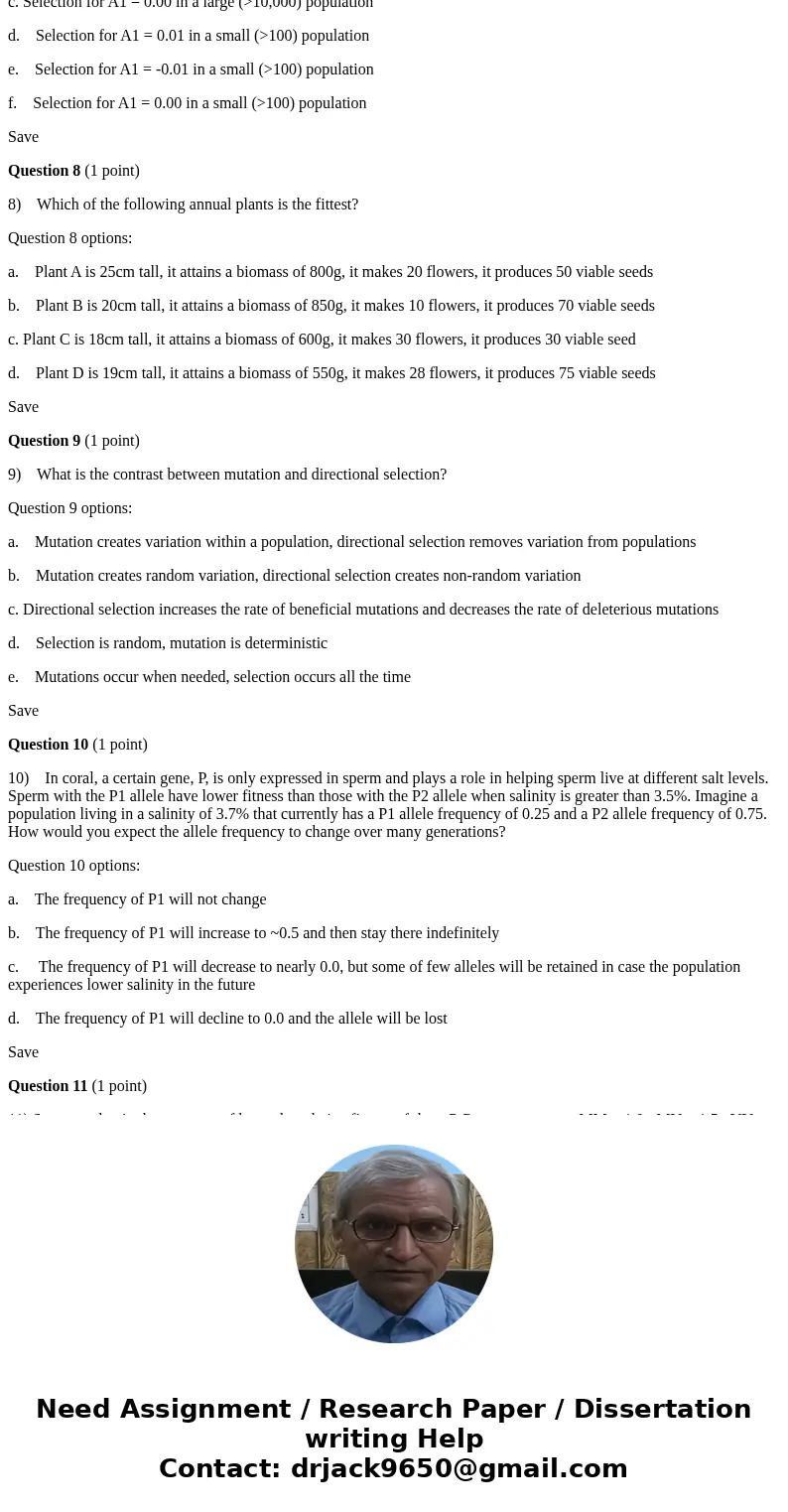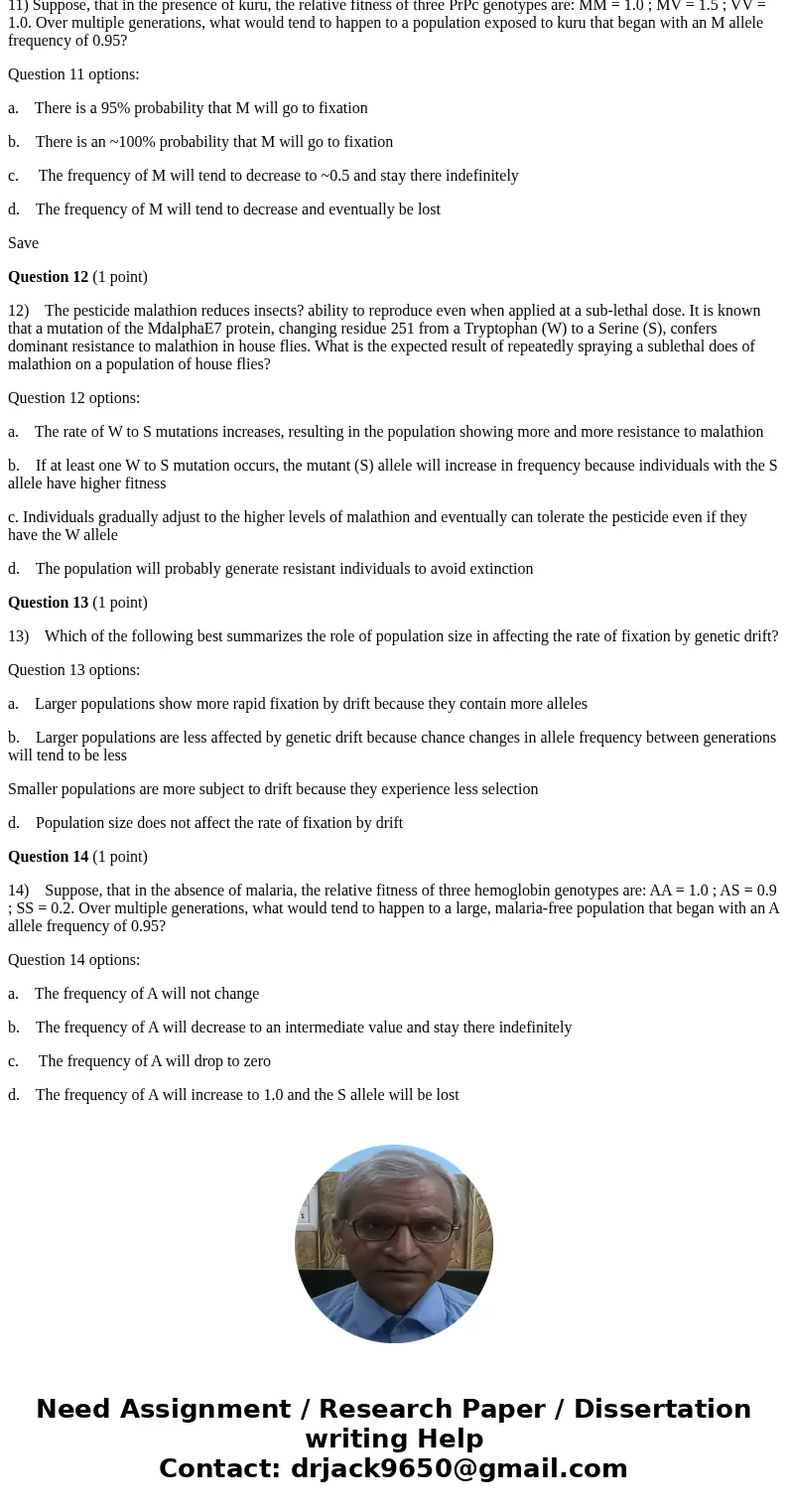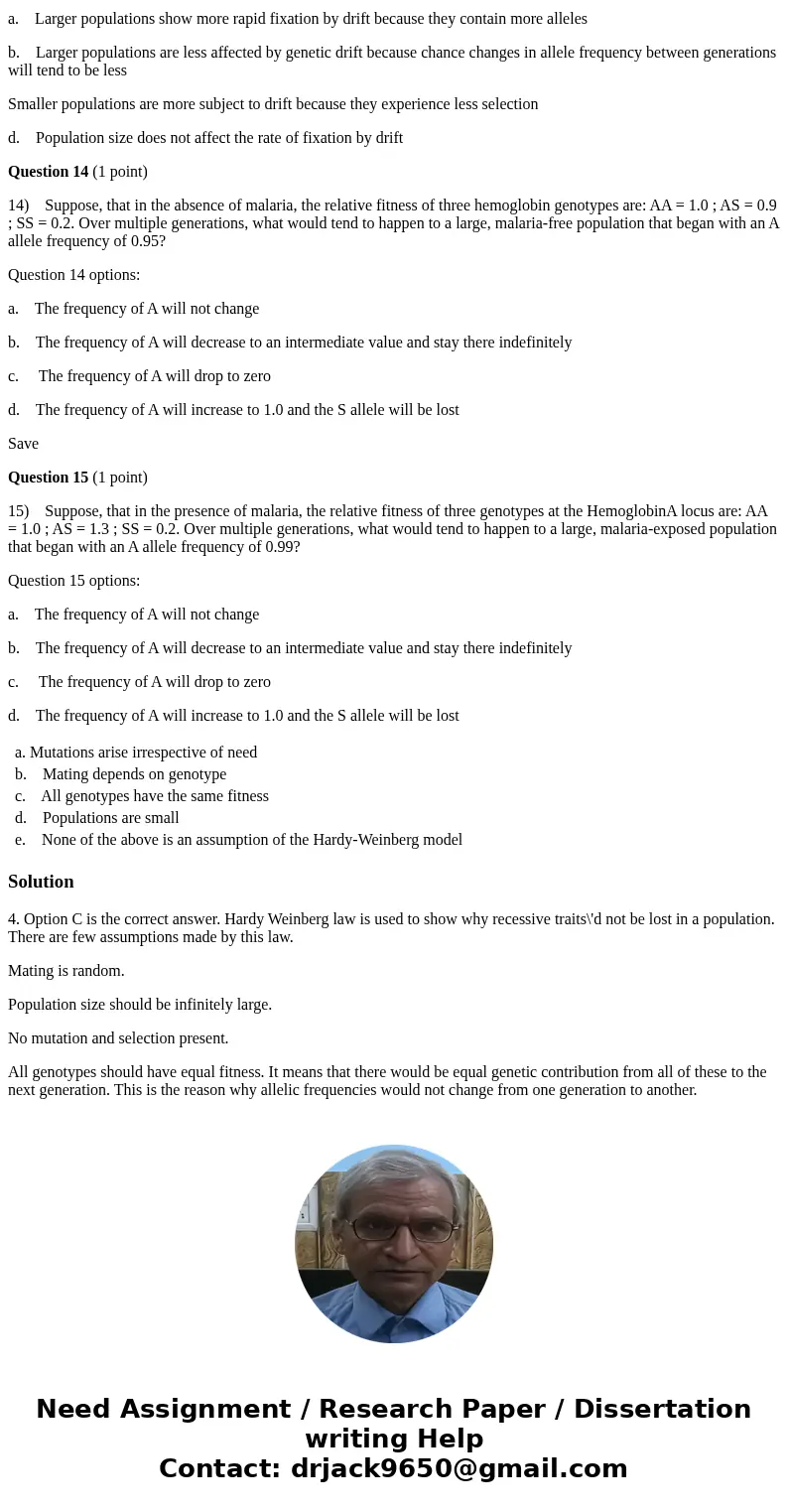NEED IT REALLY FAST WITHIN 15MINS Which of the following is
NEED IT REALLY FAST... WITHIN 15MINS!!!!!
Which of the following is an assumption of the Hardy-Weinberg model?
Question 4 options:
a. Mutations arise irrespective of need
b. Mating depends on genotype
c. All genotypes have the same fitness
d. Populations are small
e. None of the above is an assumption of the Hardy-Weinberg model
Save
Question 5 (1 point)
5) A population contains N diploid organisms. A mutant allele is present as a single copy. This mutant allele has identical fitness to all other alleles at this locus. What is the probability that this mutant allele will eventually go to fixation?
Question 5 options:
a. 0
b. 1/(2N)
c. 1/(N)
d. 1
e. It cannot be determined
Save
Question 6 (1 point)
6) Which of the following is true of evolution by both genetic drift and directional selection?
Question 6 options:
a. They help populations become better adapted to their environment
b. They are random processes
c. They remove genetic variation from populations
d. They are more effective is small populations
Save
Question 7 (1 point)
7) Here is the result of 10 identical simulations run in the program RedLynx. All started with an allele frequency of 10%. Which of these settings is most likely to have yielded such a pattern?
Question 7 options:
a. Selection for A1 = 0.01 in a large (>10,000) population
b. Selection for A1 = -0.01 in a large (>10,000) population
c. Selection for A1 = 0.00 in a large (>10,000) population
d. Selection for A1 = 0.01 in a small (>100) population
e. Selection for A1 = -0.01 in a small (>100) population
f. Selection for A1 = 0.00 in a small (>100) population
Save
Question 8 (1 point)
8) Which of the following annual plants is the fittest?
Question 8 options:
a. Plant A is 25cm tall, it attains a biomass of 800g, it makes 20 flowers, it produces 50 viable seeds
b. Plant B is 20cm tall, it attains a biomass of 850g, it makes 10 flowers, it produces 70 viable seeds
c. Plant C is 18cm tall, it attains a biomass of 600g, it makes 30 flowers, it produces 30 viable seed
d. Plant D is 19cm tall, it attains a biomass of 550g, it makes 28 flowers, it produces 75 viable seeds
Save
Question 9 (1 point)
9) What is the contrast between mutation and directional selection?
Question 9 options:
a. Mutation creates variation within a population, directional selection removes variation from populations
b. Mutation creates random variation, directional selection creates non-random variation
c. Directional selection increases the rate of beneficial mutations and decreases the rate of deleterious mutations
d. Selection is random, mutation is deterministic
e. Mutations occur when needed, selection occurs all the time
Save
Question 10 (1 point)
10) In coral, a certain gene, P, is only expressed in sperm and plays a role in helping sperm live at different salt levels. Sperm with the P1 allele have lower fitness than those with the P2 allele when salinity is greater than 3.5%. Imagine a population living in a salinity of 3.7% that currently has a P1 allele frequency of 0.25 and a P2 allele frequency of 0.75. How would you expect the allele frequency to change over many generations?
Question 10 options:
a. The frequency of P1 will not change
b. The frequency of P1 will increase to ~0.5 and then stay there indefinitely
c. The frequency of P1 will decrease to nearly 0.0, but some of few alleles will be retained in case the population experiences lower salinity in the future
d. The frequency of P1 will decline to 0.0 and the allele will be lost
Save
Question 11 (1 point)
11) Suppose, that in the presence of kuru, the relative fitness of three PrPc genotypes are: MM = 1.0 ; MV = 1.5 ; VV = 1.0. Over multiple generations, what would tend to happen to a population exposed to kuru that began with an M allele frequency of 0.95?
Question 11 options:
a. There is a 95% probability that M will go to fixation
b. There is an ~100% probability that M will go to fixation
c. The frequency of M will tend to decrease to ~0.5 and stay there indefinitely
d. The frequency of M will tend to decrease and eventually be lost
Save
Question 12 (1 point)
12) The pesticide malathion reduces insects? ability to reproduce even when applied at a sub-lethal dose. It is known that a mutation of the MdalphaE7 protein, changing residue 251 from a Tryptophan (W) to a Serine (S), confers dominant resistance to malathion in house flies. What is the expected result of repeatedly spraying a sublethal does of malathion on a population of house flies?
Question 12 options:
a. The rate of W to S mutations increases, resulting in the population showing more and more resistance to malathion
b. If at least one W to S mutation occurs, the mutant (S) allele will increase in frequency because individuals with the S allele have higher fitness
c. Individuals gradually adjust to the higher levels of malathion and eventually can tolerate the pesticide even if they have the W allele
d. The population will probably generate resistant individuals to avoid extinction
Question 13 (1 point)
13) Which of the following best summarizes the role of population size in affecting the rate of fixation by genetic drift?
Question 13 options:
a. Larger populations show more rapid fixation by drift because they contain more alleles
b. Larger populations are less affected by genetic drift because chance changes in allele frequency between generations will tend to be less
Smaller populations are more subject to drift because they experience less selection
d. Population size does not affect the rate of fixation by drift
Question 14 (1 point)
14) Suppose, that in the absence of malaria, the relative fitness of three hemoglobin genotypes are: AA = 1.0 ; AS = 0.9 ; SS = 0.2. Over multiple generations, what would tend to happen to a large, malaria-free population that began with an A allele frequency of 0.95?
Question 14 options:
a. The frequency of A will not change
b. The frequency of A will decrease to an intermediate value and stay there indefinitely
c. The frequency of A will drop to zero
d. The frequency of A will increase to 1.0 and the S allele will be lost
Save
Question 15 (1 point)
15) Suppose, that in the presence of malaria, the relative fitness of three genotypes at the HemoglobinA locus are: AA = 1.0 ; AS = 1.3 ; SS = 0.2. Over multiple generations, what would tend to happen to a large, malaria-exposed population that began with an A allele frequency of 0.99?
Question 15 options:
a. The frequency of A will not change
b. The frequency of A will decrease to an intermediate value and stay there indefinitely
c. The frequency of A will drop to zero
d. The frequency of A will increase to 1.0 and the S allele will be lost
| a. Mutations arise irrespective of need | |
| b. Mating depends on genotype | |
| c. All genotypes have the same fitness | |
| d. Populations are small | |
| e. None of the above is an assumption of the Hardy-Weinberg model |
Solution
4. Option C is the correct answer. Hardy Weinberg law is used to show why recessive traits\'d not be lost in a population. There are few assumptions made by this law.
Mating is random.
Population size should be infinitely large.
No mutation and selection present.
All genotypes should have equal fitness. It means that there would be equal genetic contribution from all of these to the next generation. This is the reason why allelic frequencies would not change from one generation to another.




 Homework Sourse
Homework Sourse